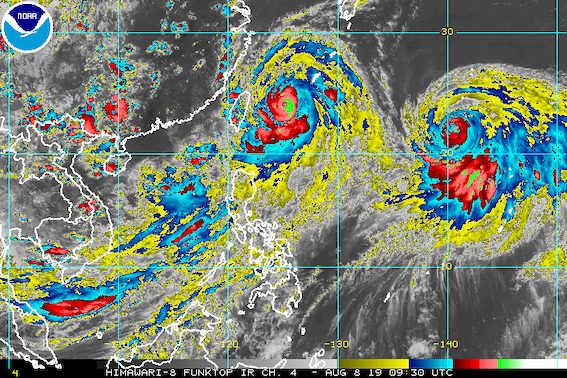SUMMARY
This is AI generated summarization, which may have errors. For context, always refer to the full article.

What’s the weather like in your area? Tweet us at @rapplerdotcom.
MANILA, Philippines – Typhoon Hanna (Lekima) will leave the Philippine Area of Responsibility (PAR) soon, but the rain from the southwest monsoon or hanging habagat will continue.
In a bulletin issued 5 pm on Thursday, August 8, the Philippine Atmospheric, Geophysical, and Astronomical Services Administration (PAGASA) said Hanna is now 505 kilometers northeast of Basco, Batanes.
The typhoon slightly accelerated, now moving north northwest at 20 kilometers per hour (km/h) from the previous 15 km/h. It is approaching the southern part of Japan’s Ryukyu Islands.
According to PAGASA, Hanna is expected to leave PAR between late Thursday evening and early Friday morning, August 9.
Hanna maintained its strength, still with maximum winds of 185 km/h and gustiness of up to 230 km/h.
Only Batanes remains under Signal No. 1. The tropical cyclone wind signal for the Babuyan Group of Islands has already been lifted.
But PAGASA warned that Hanna’s outer rainbands and the southwest monsoon will still bring light to heavy rain and gusty winds to Batanes and the Babuyan Group of Islands on Thursday evening and Friday.
Only Hanna’s outer rainbands have been affecting extreme Northern Luzon since the typhoon did not make landfall in the Philippines.
The enhanced southwest monsoon is also triggering more rain. Below is the latest list of affected areas.
Thursday evening, August 8, to Friday afternoon, August 9
- Moderate to heavy monsoon rain
- Ilocos Region
- Cordillera Administrative Region
- Zambales
- Bataan
- Occidental Mindoro
- northern part of Palawan including Calamian Islands
- Light to heavy monsoon rain
- Metro Manila
- Calabarzon
- rest of Central Luzon
- rest of Mimaropa
- Western Visayas
Friday afternoon, August 9, to Saturday afternoon, August 10
- Light to heavy monsoon rain
- Ilocos Region
- Cordillera Administrative Region
- Zambales
- Bataan
PAGASA advised residents to stay on alert for possible flash floods and landslides. Gusty conditions will also continue in most of Luzon and the Visayas due to the enhanced southwest monsoon. (READ: FAST FACTS: Tropical cyclones, rainfall advisories)
“Huwag tayong magpakakampante pa rin, dahil patuloy pa rin po ‘yung habagat,” said PAGASA Weather Specialist Benison Estareja.
(Let’s not be complacent, because the effects of the southwest monsoon will continue.)
Travel also remains risky in the seaboards of Luzon and the Visayas, and northern and eastern seaboards of Mindanao.

Hanna is the Philippines’ 8th tropical cyclone for 2019, and the 1st for the month of August. It is also the country’s 1st tropical cyclone to reach typhoon status in 2019. (READ: LIST: PAGASA’s names for tropical cyclones in 2019)
Aside from Hanna, PAGASA also gave updates on two other weather systems:
- low pressure area (LPA) inside PAR
- Typhoon Krosa outside PAR
The LPA inside PAR, located west of Northern Luzon, has already dissipated.
Meanwhile, Typhoon Krosa intensified again. It now has maximum winds of 155 km/h from the previous 130 km/h and gustiness of up to 190 km/h from the previous 160 km/h.
Krosa is located 1,950 kilometers east of extreme Northern Luzon, almost stationary or hardly moving. It is not expected to enter PAR.
The country gets an average of 20 tropical cyclones annually, but since 2019 is an El Niño year, only 14 to 18 tropical cyclones are expected.
Below is the estimated number of tropical cyclones from August to December:
- August – 2 to 4
- September – 2 to 4
- October – 2 or 3
- November – 1 or 2
- December – 0 or 1
PAGASA declared the start of the rainy season last June 14. – Rappler.com
Add a comment
How does this make you feel?
There are no comments yet. Add your comment to start the conversation.